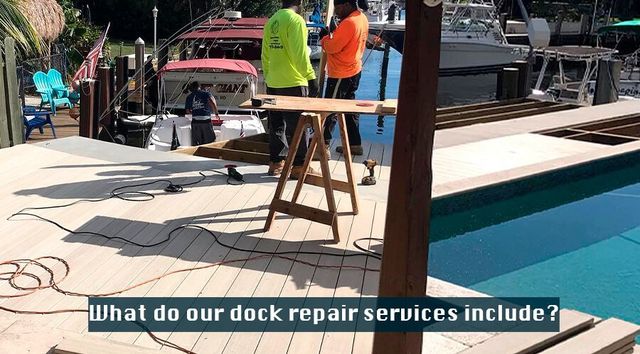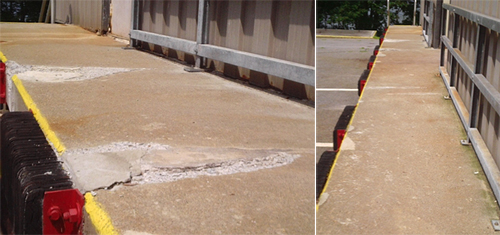How to Address Common Dock Fixing Issues for Safe Water Tasks

Identifying Common Dock Issues
Determining typical dock concerns is crucial for maintaining the capability and safety and security of your waterfront residential property. Regular evaluations can assist uncover issues prior to they come to be extreme, guaranteeing both the longevity of the dock and the security of those who utilize it. One common problem is loose or corroded bolts. With time, screws, bolts, and other bolts can become loosened due to continuous direct exposure to water and weather aspects, bring about structural instability.
An additional usual problem is the destruction of flotation protection gadgets. These tools are necessary for keeping the dock resilient, and any damage or leaks can create the dock to list or sink. Consistently inspecting for leaks or waterlogged floats can preempt much more significant problems.
In addition, algae and barnacle build-up on the dock's surface can create slippery and harmful problems. This biofouling not just presents a risk to customers yet can also speed up the wear and tear of the dock products.
Finally, examining for signs of rust on metal components is important. Rust can jeopardize the honesty of the dock's structure, making it hazardous. By routinely determining these typical dock issues, you can make sure that your dock remains secure and functional for years to find.
Fixing Rotting Timber
When resolving the concern of decaying timber on your dock, it is critical to act swiftly to avoid further deterioration. Begin by extensively checking the whole structure to identify all influenced areas. Utilize a screwdriver to probe the timber; if it sinks in conveniently, the wood is likely deteriorated and needs immediate interest.
When determined, remove the decayed areas using a saw or sculpt. Make sure to cut back to healthy, solid wood, ensuring you remove all compromised product. After removal, deal with the remaining wood with a wood chemical to stop future rot. This treatment will certainly aid safeguard versus dampness, which is the main root cause of timber decay.
Next, change the eliminated sections with marine-grade lumber or pressure-treated timber, which are much more resistant to water damage. Safeguard the brand-new items with stainless-steel or galvanized fasteners to stop rust. Additionally, using a waterproof sealer to the brand-new timber can offer an added layer of protection.
Protecting Loosened Boards
How do you guarantee your dock remains safe and functional for all its individuals? One important element is safeguarding loosened boards, which can otherwise present significant threats. Loosened boards not just increase the threat of tripping but can likewise endanger the structural honesty of the entire dock.

For reinstallation, utilize galvanized or stainless steel screws, Your Domain Name as these materials use premium resistance to rust in marine atmospheres. Make sure the screws are long sufficient to pass through deep into the underlying assistance framework, but not so long that they stick out through the dock's surface. Pre-drilling pilot holes can help prevent the wood from splitting.
Finally, preserve a normal examination schedule to recognize and resolve any type of brand-new concerns promptly. By protecting loosened boards successfully, you contribute to the general safety and security and long life of your dock, making it a trustworthy system for water tasks.
Maintaining Unstable Pilings
Guaranteeing the stability of unstable pilings is critical to maintaining a secure and functional dock. Unsteady pilings can jeopardize the entire framework, posing considerable threats to individuals and potentially causing expensive repairs. The primary step in supporting these crucial elements is a detailed inspection. Analyze the pilings for indications of rot, damages, or shifting. Utilize a level to look for vertical positioning and guarantee they are driven deep sufficient into the substratum to offer appropriate support.
If the pilings are located to be unsteady, one reliable approach for reinforcement is making use of additional bracing. Cross-bracing with treated lumber or galvanized steel can significantly enhance security. Support the braces securely to both the pilings and the dock framework to disperse lots evenly.

Routine maintenance and periodic review of the pilings' stability are critical to making certain long-term dock safety and functionality.
Changing Rusty Hardware
Addressing unstable pilings is just one facet of keeping a dock's integrity; another important problem is changing rustic hardware. With time, direct exposure to moisture and salt can result in the oxidation and rust of bolts, screws, and braces, compromising the whole structure's security. Normal assessment for corrosion is important, especially after extreme climate or seasonal adjustments.
When corroded hardware is identified, immediate action is called for. Begin by picking marine-grade stainless-steel or galvanized hardware, both created to stand up to the rough marine setting. Make certain that you have the suitable devices, such as wrenches and screwdrivers, to safely eliminate the old, corroded pieces without creating further damages to the dock.
After removing the corroded equipment, browse around these guys extensively tidy the affected areas to remove any kind of residual corrosion or debris. Apply a rust-inhibiting primer to revealed metal surface areas before setting up the new hardware. Tighten all components firmly to protect against future helping to loosen, and regularly check the installations to ensure recurring security.
Changing rusty hardware not only prolongs the dock's life-span but likewise dramatically improves the safety and security of water activities. By proactively handling corrosion, you secure both the structure and its customers, guaranteeing a pleasurable and safe waterfront experience.
Conclusion
Regular evaluations and maintenance are important to resolve usual dock repair service issues and guarantee risk-free water tasks. By recognizing and correcting problems such as decomposing wood, loosened boards, unstable pilings, and rusty equipment, architectural stability and longevity can be significantly improved. The application of ideal treatments and marine-grade materials better fortifies the dock against environmental stressors. Such aggressive measures contribute to the overall safety and security and functionality of dock he said frameworks, fostering a safe and secure environment for water-based activities.
Making sure the safety and security of water tasks pivots significantly on the appropriate maintenance and repair service of anchors (Dock Repairs). These tools are vital for keeping the dock resilient, and any kind of damages or slits can trigger the dock to checklist or sink. By consistently identifying these usual dock problems, you can guarantee that your dock continues to be practical and safe for years to come
Making sure the stability of unstable pilings is critical to maintaining a practical and safe dock.Normal assessments and upkeep are necessary to resolve common dock fixing concerns and make certain risk-free water tasks.